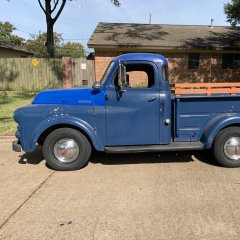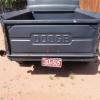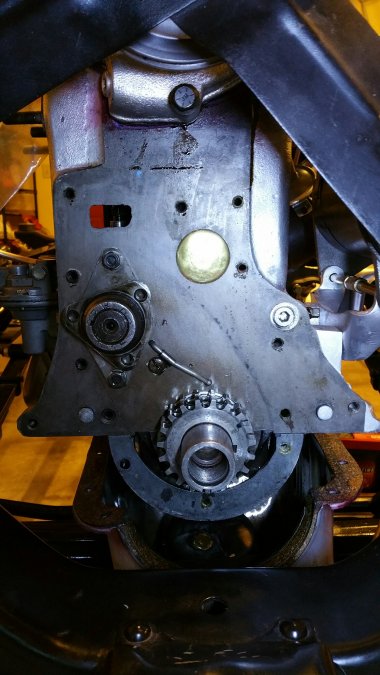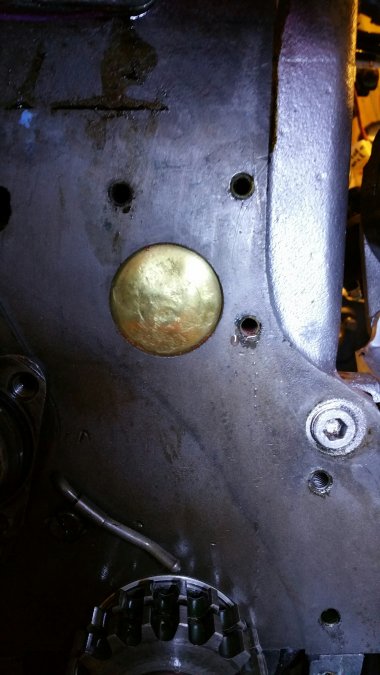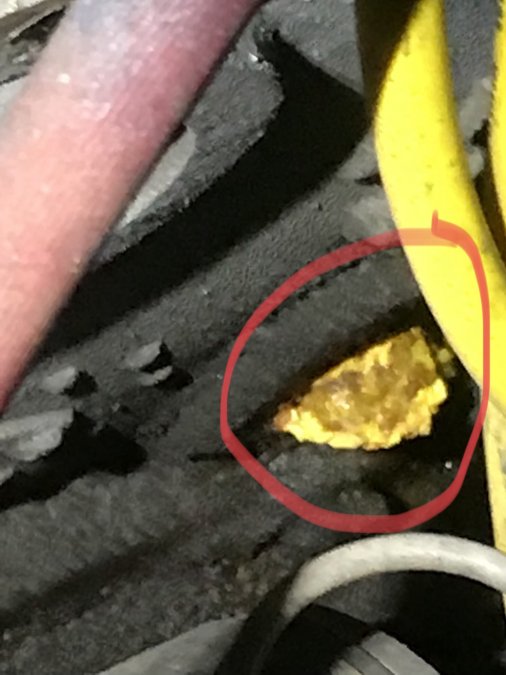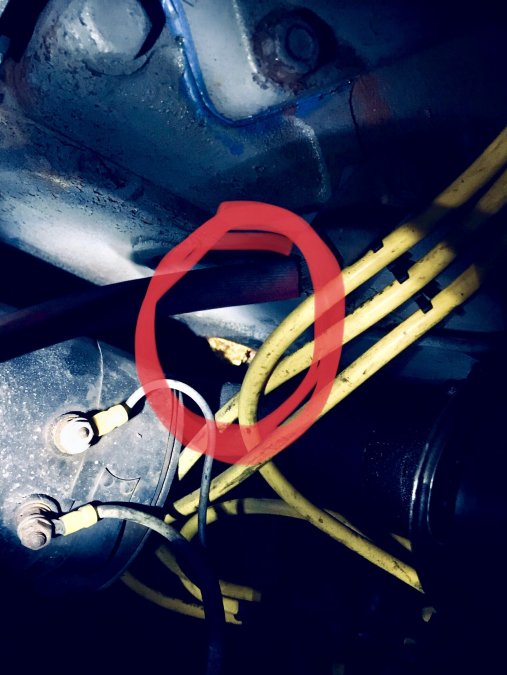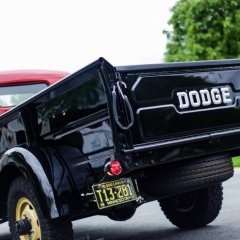Search the Community
Showing results for tags 'Leak'.
-
Hey everyone. New to the forum. First 1941 rebuild here. Just finished a 1967 Big Block Corvette with my buddies. The Back Story: In the middle of a power-train rebuild on our families 1941 Dodge Luxury Liner. Car has a 3 speed with the fluid drive. We pulled the fluid drive out of the car. We've had the engine rebuilt. Also rebuilt the transmission our self. Everything was running smooth until the fluid drive unit. When we pulled out the fluid drive, it was still full of fluid. No leaks. We drained the old fluid, and used some de-greaser to clean her up. We filled up the fluid drive unit and let it sit ready for install and to test for leaks. So far so good. The Problem: About a week later, we stood up the fluid drive unit as if you would mount it in the car, spun it around by hand to check, and now it leaks like a dripping facet out the bottom. Not sure if we some how manged the seal by lifting it improperly. Hate to think these could be that fragile. I have never pulled one of these apart, but would love if anyone has a guide, advice or a recommended shop who can assist. I am located in southern California. Cant wait to get this baby sealed up and back in the car. If anyone knows a trans shop or some steps. We tried using a combination of bear pullers, you name it. Maybe we're going at it the wrong way and in over our heads. I have on hand a fluid drive seal kit. Brand new that just came in. I can not remember the vendor I ordered it from.
- 12 replies
-
- Fluid drive
- leak
- (and 5 more)
-
I have had an oil leak since owning my 1951 Dodge B3B, I have always assumed that it was from the drain plug. So I changed to a new plug but still the leak continued. So at the last oil change, I changed to a nylon washer in an attempt to stop the leak. But the leak continued. The leak is not catastrophic but is annoying. Of course I have maintained a drip pan on my shop floor to catch the leaks, but I still wanted to secure a solution. So yesterday in part due to current home confinement and the arrival of warm weather, I cleaned the exterior of the oil pan with degreaser and then using body powder, I powdered the pan in order to locate the source of the leak. While the oil primary drips to the ground from the drain plug, that is only because it is the lowest point on the oil pan. It is actually leaking from the dipstick connection on the side of the oil pan running down the side of the pan, and finally across the bottom of the pan to the drain plug. Since this connection point appears to be spot welded or riveted onto the oil pan, the most be a method to reseal the seam between the two pieces. So my question, Has anyone else experienced this issue? Has anybody found a viable solution? or Do I just the drip pan?
-
I'm completing a total rebuild of the engine, but my problem has been coolant leaks. The two longer manifold studs leaked. One of the water pump bolts leaked. And one head bolt leaked. I've solved all those problems using aviation gasket maker but I have one more leak that has me more concerned than the others. I'm somehow getting coolant in the oil. When I cracked open the drain plug I got a stream of coolant, maybe an ounce or two, before I saw any oil drain out. So now I've taken the front of the engine apart again. I gave the welch plug another good smack with a 13/16 socket for good measure. From what I can tell the real problem is water getting past one of the timing cover bolts and soaking through the backing plate gasket. Initially I used aviation gasket maker on the timing cover bolts, but I did not smear it on the gasket. When I reassemble everything I WILL generously coat the gasket and smear the female bolt holes with AGM before I coat the bolts and insert them. Other than timing cover bolts and the front welch plug, is there any other way for coolant to get into the oil? Is Aviation Gasket Maker the best way to seal the threads or is there a better sealant? I think the hole next to the welch plug leaked.
- 27 replies
-
- welch plugs
- coolant
-
(and 6 more)
Tagged with:
-
1949 Chrysler Windsor (C45) with flathead 6. The car sat for 12 years. Five valves were stuck open. After a few weeks of patiently working with them, I finally got them all free. Because I put so much lightweight oil (Marvel Mystery, ATF/acetone, WD-40) on the valves, I changed the oil before I tried to start it. The car is now running. Of course, it smoked to high heaven when I first started it. Now that I am past that there is a definite pattern and it is as follows: When the car is first started, the exhaust runs clean for about 7-8 minutes. Then it starts to smoke. The carb has been rebuilt. The plugs do have black soot on them, so some adjustments need to be made. I am concerned about compression. Compression is as follows: four cylinders at 80, one at 75, and one at 85. That is better than when I tested them before it was running; however, The car has had a total running time of 80-90 minutes now. If I read the manual correctly, it should be 120-150. Thoughts? Also, while working with the valves, I pulled the head. I put on a new gasket and tightened according to proper order and torque. I have attached a picture of a leak. It is the bolt the throttle linkage sets upon. I assume I need to take it out, put joint compound on it and tighten it back down. Or, is this more serious than I think? I checked my oil, it looks great! No antifreeze in oil.
- 11 replies
-
- smokes
- compression
-
(and 1 more)
Tagged with:
-
1949 Plymouth Spec Dlx, have had an intermittent leak for a week. I could see the shine around the bottom of the engine but could not find where it was coming from. First thought it was the fuel pump for various reasons, but the clear liquid did not smell like gas, while checking the oil I just found this clump of yellow crystal-like residue “growing” on the freeze plug. Most likely the source of my leak but what on earth is the build up on the engine?? do I have to pull the engine to replace the plug? more info: I installed a new (modern) 3 core radiator earlier this summer as I was constantly overheating, it solved the problem but my buddy thinks it may be putting too much pressure on the cooling system. Could that be the reason for the leaky freeze plug and the residue?
- 7 replies
-
- special deluxe
- plymouth
-
(and 3 more)
Tagged with:
-
A few days ago I grease the fitting on the radiator fan on my 1947 Plymouth Deluxe. Today I noticed a steady dribble of coolant coming from inside the fan housing. What is the fix, do I have to pull the entire radiator out? Not sure why this would happen only after greasing. Thanks, Chad
-
Anyone have any recommendations for the best type of sealer to use (or avoid) or other must-do items to fix leaky gutters? I recently discovered that water was coming into the interior up around the gutters, and while I initially thought it might be just a few rust pinholes, it didn't take more than a few seconds up on the ladder to see what the problem was. Of course, on a less-tall vehicle, I might have spotted it sooner. Several of the spot welds appear to have rusted through and/or separated. Water is coming in through the gap between the two layers of sheet metal. Plenty of dirt and even a little bit of moss. See photo... It's depressing. Of course, the right thing to do is to strip it down to bare metal and weld it, but that is not in the cards. You'd have to remove the entire roof to get the rust out in between. My tentative plan is to clean out the gutters as best I can (water, toothbrush, air gun, wire brush, maybe even a pressure washer) and then apply a seam sealer. I'm leaning towards "Dynatron 550" but open to suggestion of other products, prep/application tips, etc. Ideally I'd like something that I can really force into the gap, similar in thickness to Bondo or household painter's caulk (though I understand I can't use house caulk). Self-leveling would presumably run to the end of the gutters and out, so that's no good. The sealer needs to stick to paint and to bare metal and hopefully to dirty/rusty metal too. Needs to be paintable and sun-stable. Doesn't have to look great because you'd have to be 9 feet tall to see it.
- 20 replies
-
- seam sealer
- gutter
-
(and 6 more)
Tagged with:
-
I replaced my water pump twice but it still has a drip from off the oilpan near the front. Could it be a leak from a timing cover bolt? I don't remember if any of these bolts go thru to the water jackets in the block. My Engine is from a 1946 Dodge 218 or 230 I think, but it came in my 1934 Plymouth when I bought it. I love the way it runs and drives, but this has become pretty annoying. AJ
- 7 replies
-
- Water Pump
- Leak
-
(and 1 more)
Tagged with:
-
So I've been wondering this for a while, taking the pics for Hank yesterday it highlighted it again for me. In normal light it doesn't look as bad as with the camera flash, but is this a "normal" look for a carb? Seems it should be cleaner than it is.... is it leaking near the input? Or along the interface between the halves? OR?????

